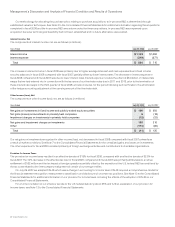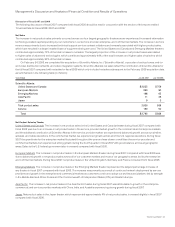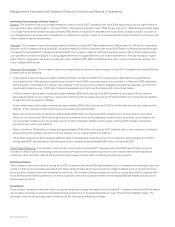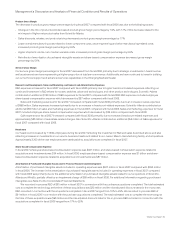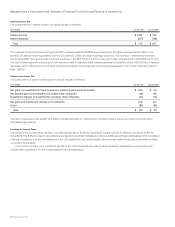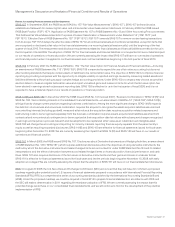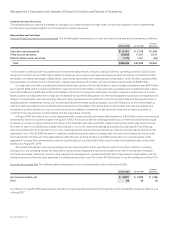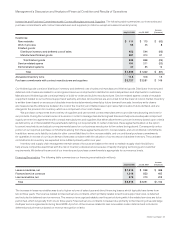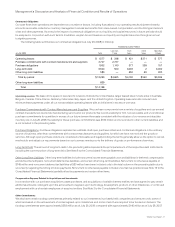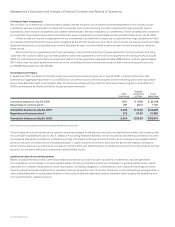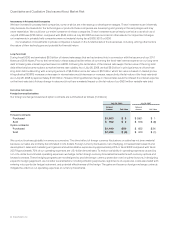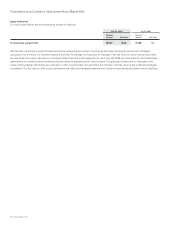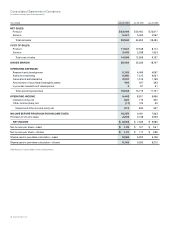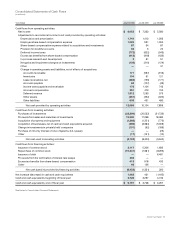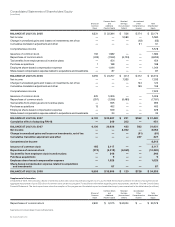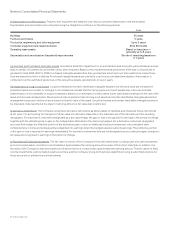Cisco 2008 Annual Report Download - page 37
Download and view the complete annual report
Please find page 37 of the 2008 Cisco annual report below. You can navigate through the pages in the report by either clicking on the pages listed below, or by using the keyword search tool below to find specific information within the annual report.
42 Cisco Systems, Inc.
Management’s Discussion and Analysis of Financial Condition and Results of Operations
Off-Balance Sheet Arrangements
We consider our investments in unconsolidated variable interest entities to be off-balance sheet arrangements. In the ordinary course
of business, we have investments in privately held companies and provide financing to certain customers through our wholly owned
subsidiaries, which may be considered to be variable interest entities. We have evaluated our investments in these privately held companies
and customer financings and have determined that there were no significant unconsolidated variable interest entities as of July 26, 2008.
Certain events can require a reassessment of our investments in privately held companies or customer financings to determine if they
are variable interest entities and if we would be regarded as the primary beneficiary. As a result of such events, we may be required to make
additional disclosures or consolidate these entities. Because we may not control these entities, we may not have the ability to influence
these events.
We provide financing guarantees, which are generally for various third-party financing arrangements to channel partners and other
customers. We could be called upon to make payment under these guarantees in the event of nonpayment to the third party. As of July 26,
2008, the total maximum potential future payments related to these guarantees was approximately $830 million, of which approximately
$610 million was recorded as deferred revenue on the consolidated balance sheet in accordance with revenue recognition policies
and FASB Interpretation No. 45 (“FIN 45”).
Stock Repurchase Program
In September 2001, our Board of Directors authorized a stock repurchase program. As of July 26, 2008, our Board of Directors had
authorized an aggregate repurchase of up to $62 billion of common stock under this program and the remaining authorized repurchase
amount was $8.4 billion with no termination date. The stock repurchase activity under the stock repurchase program in fiscal 2007 and
2008 is summarized as follows (in millions, except per-share amounts):
Shares
Repurchased
Weighted-
Average Price
per Share
Amount
Repurchased
Cumulative balance at July 29, 2006 1,931 $ 18.36 $ 35,448
Repurchase of common stock(1) 297 26.12 7,781
Cumulative balance at July 28, 2007 2,228 $ 19.40 $ 43,229
Repurchase of common stock(1) 372 27.80 10,350
Cumulative balance at July 26, 2008 2,600 $ 20.60 $ 53,579
(1) Includes stock repurchases that were pending settlement as of period end.
The purchase price for the shares of our common stock repurchased is reflected as a reduction to shareholders’ equity. In accordance with
Accounting Principles Board Opinion No. 6, “Status of Accounting Research Bulletins,” we are required to allocate the purchase price of the
repurchased shares as (i) a reduction to retained earnings until retained earnings are zero and then as an increase to accumulated deficit
and (ii) a reduction of common stock and additional paid-in capital. Issuance of common stock and the tax benefit related to employee
stock incentive plans are recorded as an increase to common stock and additional paid-in capital. As a result of future repurchases, we may
report an accumulated deficit as a component in shareholders’ equity.
Liquidity and Capital Resource Requirements
Based on past performance and current expectations, we believe our cash and cash equivalents, investments, and cash generated
from operations, and our ability to access capital markets, including committed credit lines, will satisfy our working capital needs, capital
expenditures, investment requirements, stock repurchases, contractual obligations, commitments, future customer financings, and other
liquidity requirements associated with our operations through at least the next 12 months. There are no other transactions, arrangements, or
other relationships with unconsolidated entities or other persons that are reasonably likely to materially affect liquidity, the availability, and
our requirements for capital resources.


